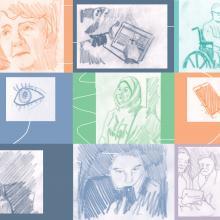Background
Social is media in increasingly used by all kinds of people in their private and professional lives and by all kinds of organisations to find and share information. In our daily work at Iriss we use services such as Vimeo for sharing video, Soundcloud for audio and Flickr for still images.We use Google Docs to work collaboratively on ideas and we use meeting schedulers such as Doodle to take the pain out of co-ordinating different people working in different organisations.
The economics
We use these tools because they are inexpensive or free, and easy to use. For example, a Vimeo Plus account costing about £60 per year allows us to share video case studies quickly and easily and, compared to the cost of creating and mailing DVDs, represents exceptionally good value for money. In short, video streaming services such as Vimeo and Youtube make it economically viable to share knowledge and information in video format. Yet many local authorities block access to Vimeo.
Over the years, we have developed a collection of still images which is freely available for illustrating publications or enlivening learning materials. We publish them on Flickr Iriss photo collection. Why? Well, the annual subscription is £20 and Flickr handles all the technical matters, saving our staff time and effort. We had been quoted something like £2000 to create an image storage and display feature using a proprietary software package. When a local authority wanted to use some of these images in a learning resource on dementia they were denied access to Flickr. Had we invested the £2000 or so, access would not have been a problem.
If we are to make the pounds go further we have to use the most economical tools, which means exploiting the economies and efficiencies offered by social media.
The survey
During February 2012, we ran a survey which enabled participants to check whether or not their employer allowed access to a selection of commonly used social media sites. The respondents were presented with a link to each site in turn (see list in footnote below) and asked to report whether they were allowed to connect or blocked or what message appeared.
Responses
Some 225 people responded and the results show that access varies considerably. Sixty-seven per cent were from local authorities, and 20% from voluntary organisations. The remainder were from central government, higher education, non departmental public bodies, inspectorates etc. We offered respondents the opportunity to comment and this yielded some interesting insights into cultural issues that can arise when using social media at work.
the firewall creates significant buffering issues, and very few if any NCs [Network Computers] are enabled for sound. So, you may be able to see a video on a website, but you will not hear anything and to all intents and purposes it will be unwatchable
Another concern was that time spent online might not be regarded as productive:
The length of time spent online is monitored which makes some staff nervous accessing the internet. This creates a hidden barrier and perhaps sends a tacit message that internet usage is not acceptable.
The attached graphs (click the image to make it bigger) illustrate the extent to which the various tools and services are accessible. While it's encouraging that more than 50% can access video on Vimeo (a channel that Iriss uses to distribute video) the converse is that around 44% of respondents cannot access these videos. Soundcloud is a cheap and effective way of sharing audio files, yet 49% of our respondents were denied access. Security and/or bandwidth are often cited as reasons for blocking access, yet services such as Soundcloud are unlikely to pose a threat on either ground. Flickr was accessible to more than half the respondents, but the other 43% will have to do without.
Just over 75% of respondents were blocked from Facebook. Yet many community groups use Facebook pages to communicate and share information: for example Carers UK. Carers UK also use Flickr to share photographs. Facebook is where The Princess Royal Trust for Carers has been successfully lobbying to put the concerns of unpaid carers on the political agenda: see Carers Votes Count.
Our report - The future for personalisation: service users, carers and digital engagement - has many more examples of social media in action.
The figures suggest that a substantial proportion of practitioners working in social services are missing out by being denied access to these communication channels.
Getting unblocked
Most local authorities say that they have procedures for unblocking access, but this is what one respondent reported:
... as the process says I phoned the helpline to get access to this [Vimeo, a streaming video service used by Iriss]. I had to give the web address and confirm that this was for work usage - no problem there. However, I now have to get my line manager or above to email IT to confirm that my request for access is approved. If I want this access to be for more than myself I have to give a list of names - hence to have everyone in social work able to access video clips on Iriss I would have to list all 2,000 staff names...
The problem is that this process is time consuming and troublesome for users, line managers and help desks alike. In 2010, SOCITIM (Society of Information Technology Management) published a report, Social media: Why ICT management should lead their organisations to embrace it. Our survey suggests that people on the frontline still face real barriers, rather than being actively encouraged to embrace social media.
The way forward
We don't live in a risk free world and perhaps it would be better for all if technical resources and expertise were deployed, encouraging and supporting staff in the safe and responsible use of these simple, cheap and effective web-based tools, rather than developing internal solutions. The Christie Commission (PDF) seems to suggest that this option at least ought to be considered:
...the public sector, at all levels, can do more to transform how it procures, manages and uses digital technology to drive better public service delivery. We need to ensure that services are tailored to meet the needs of individuals and communities - exploiting the full potential of ICT will be critical in achieving this transformation.
Just as email took some time to become mainstream, it is probable that, in time, practitioners will be trusted to act responsibly on the web (as they are in other aspects of their work) and policies on access will become more liberal. These policies should be informed through discussion between practitioners, corporate managers and network managers so that each may see the problem from the others perspective. To try to encourage this discussion, Iriss publishes a blog - Just Do It!
Do take a look and join the debate.
Footnote
The sites we tested were: Vimeo, Youtube, Google docs, Flickr, Facebook, Soundcloud, Doodle, SSKS, Wordpress, Iriss podcasts, Tinyurl, Wikipedia, LinkedIn and Instapaper




